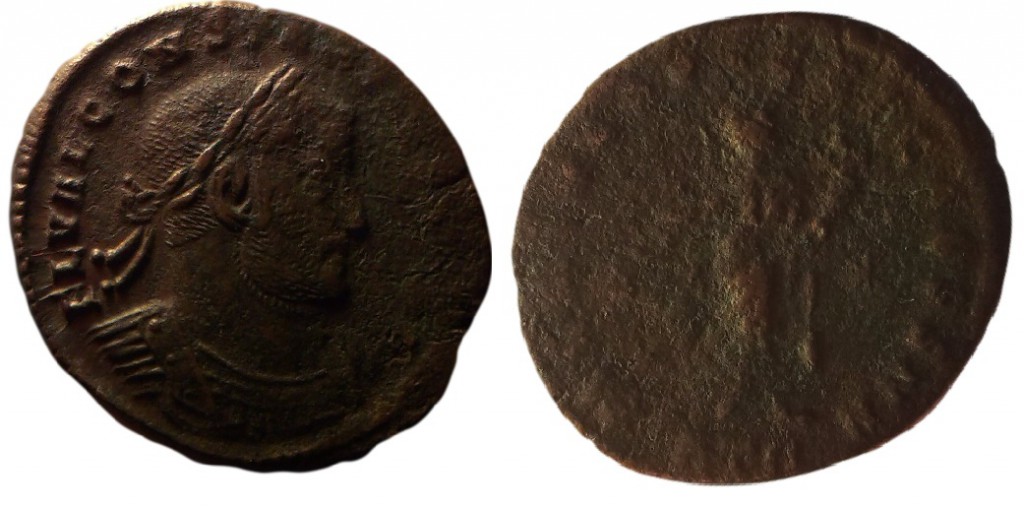July 25, 2015, by Will Leveritt
On this day in AD306 the emperor Constantius I died in York
Text by Rob Stone
Image © Mint Imperials
On the 25th July 306, Constantius I (Augustus of the Western Empire and ruler of Spain, Gaul and Britain) died in York. His troops, rather than await a new leader to be appointed for them, hailed the emperor’s son Constantine as Augustus but it was not until 324 that he would gain control over the entire empire.

AE follis of Constantius. Laureate, cuirassed bust r., FL VAL CONSTANTIVS NOB C. Reverse has Moneta l., with cornucopia and scales, M SACRA AVGG ET CAES NN. 29mm, 9.35g, 12 o’clock.
At this time, the Roman Empire was ruled by two Augusti (senior emperors) and two Caesares (junior emperors) who divided the empire between themselves. This system, called the tetrarchy, had been instituted by Diocletian a decade earlier in order to avoid the usurpations and invasions that could stem from the overextension of a single emperor. Upon the retirement or death of a senior emperor, the Caesar who served that Augustus would be promoted to replace him. A new Caesar would then be chosen by the new Augustus with the approval of his colleague. In an ideal world, the prospect of promotion and marital ties between the various emperors would dissuade the Caesares from rebellion, whilst four emperors could deal with both foreign and internal threats throughout the empire.
For the surviving Augustus Galerius, Constantius’ death should not, therefore, have posed a significant problem. Constantius’ Caesar, Severus, was a close friend of Galerius and his promotion to Augustus would have strengthened Galerius’ control over the empire. Severus would then have been able to pick his own Caesar who would have been loyal to the Augusti. However, the acclamation of Constantine as Augustus disrupted these plans. Galerius was left with a choice between accepting the decision of Constantius’ legions, which would have meant snubbing his friend and giving the Western empire to a man outside his control, or risking a rebellion and civil war. In the end he compromised – Severus was to be promoted, but Constantius was appointed as his Caesar allowing the troops and his father’s provinces to remain under his control.
However, it would take Constantine just one year to once more be hailed as Augustus: soon after Constantine became Caesar, Diocletian’s system of rule was again tested as Maxentius, son of the former Augustus Maximian, usurped power in Rome. When Severus set out to defeat the usurper, his troops defected and he was imprisoned by Maxentius. Maximian, brought out of retirement to support his son, offered Constantine his daughter’s hand and the title of Augustus in return for his aid. Constantine accepted the title but continued to spend his time defending the borders rather than become involved in the usurpation. Unsurprisingly, Galerius did not accept the claims of Maximian, Maxentius and Constantine and convened a council at Carnuntum to resolve the crisis. There he, with the support of his predecessor Diocletian, appointed another Augustus, Licinius, demoted Constantine to Caesar of the West and stripped Maxentius and Maximian of their titles. However, by 310, Maximian had returned once more and Galerius was willing to refer to both Maxentius and Constantine as Augusti.
The uneasy balance between the four Augusti was to end within the year. After Maximian failed in an attempt to usurp Constantine and was compelled to hang himself, Maxentius prepared to go to war to avenge his father. Both men looked for support in the East. There they found a situation no less tense: following Galerius’ death in 311, his Caesar Maximinus and Licinius nearly came to blows whilst dividing his provinces between themselves. Licinius and Constantine found common ground and supported one another with the promise of a marriage between Constantia (half-sister of Constantine) and Licinius. This was to come in 313.
However, before the marriage, Constantine made his move against Maxentius. In 312 he pushed forward through Italy, sweeping aside opposing forces in the North before heading for Rome. Faced with the prospect of a siege and the slow erosion of his rule, Maxentius made his stand near Saxa Rubra at the Mulvian Bridge. It was here that Constantine was reported to have seen a sign sent by the Christian god to assuring him of victory and, sure enough, Maxentius was defeated and killed in the battle.
As he entered Rome as sole ruler of the West, Constantine was once again hailed as Augustus but one man still stood between him and control over the entire Roman Empire. Licinius defeated Maximinus the following year and peace was to reign within the empire for two years before the inevitable conflict broke out in 316. After a brief war, Constantine was content to allow his rival to remain as emperor as long as two of his sons were made Caesares. However, seven years later, a dispute over boundaries and the authority of each Augustus once again led to war. This time, Licinius was not to retain his power and in 324 Constantine established his rule over the entire empire.
No comments yet, fill out a comment to be the first

Leave a Reply